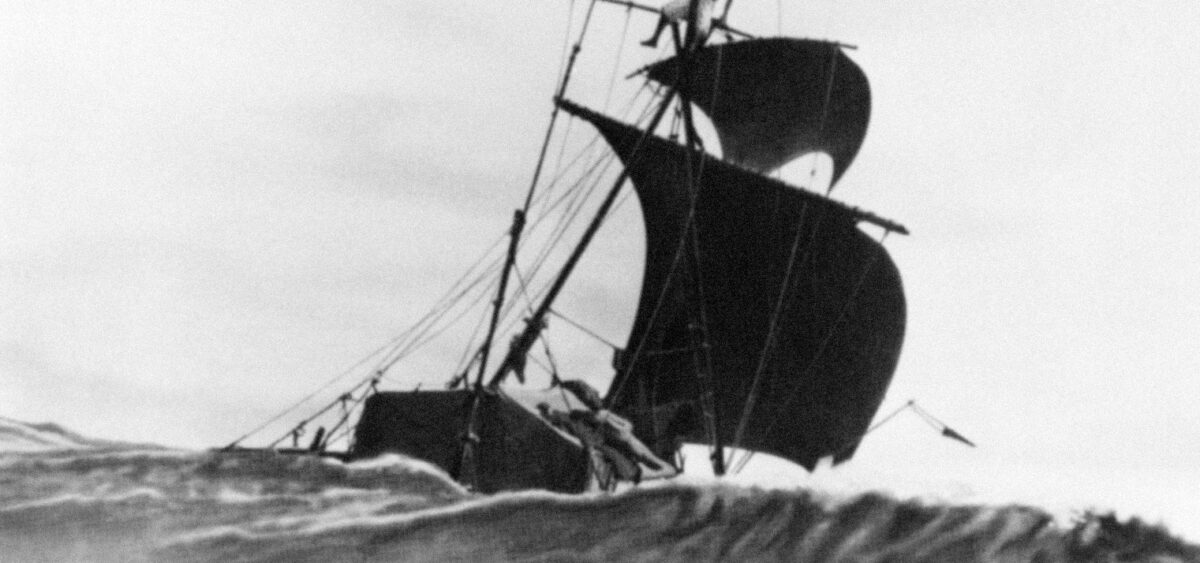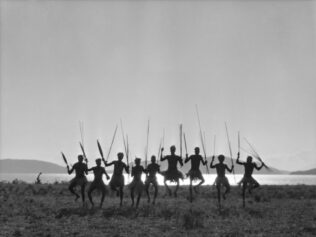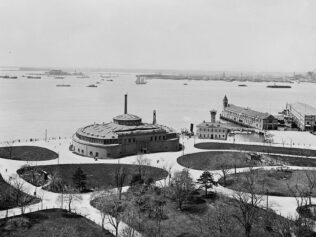
In July 2020, the world’s media reported a genetic link between Polynesians and the Indigenous peoples of Central and South America. The news wouldn’t have been heard so widely if it didn’t relate directly to the theories of the legendary Norwegian traveller Thor Heyerdahl. His Kon-Tiki expedition is one of the most famous voyages of the previous century.
The scientists who compared the DNA of 807 residents of Polynesian islands and the western coast of Central and South America established that the two peoples encountered one another around the turn of the 11th and 12th centuries. Eight decades ago, Heyerdahl declared that the Polynesians originated not in Asia, as was believed, but in South America. In response to the argument that this was impossible because they couldn’t have travelled such long distances, he decided to prove it by sailing a raft from Callao, Peru to the Tuamotu archipelago near Tahiti. Almost 75 years after the adventurers left port, the legend of the Kon-Tiki still remains in the collective memory.
David, Goliath and Thor
“It was Tiki in flesh and blood who had led Tei Tetua’s ancestors across the ocean to these islands.
“‘From where?’ I asked, and was curious to hear the old man’s reply.
“‘From Te-Fiti [The East],’ answered the old man and nodded toward that part of the horizon where the sun rose, the direction in which there was no other land except South America.”
That conversation took place in 1937 on Fatu Hiva, an island about the size of the Polish town of Zakopane (84 square kilometres), in a place where the globe is almost entirely blue. According to the aforementioned old man, Tei Tetua was once the leader of the four tribes, but he outlived all his countrymen and all his 12 wives; he was one of the few islanders who remembered and believed in their their fathers’ and grandfathers’ legends of about the great Polynesian chief-god Tika, son of the Sun. The 23-year-old Heyerdahl, who was asking the above questions, was a budding zoologist. Officially, he had come to the island with his wife to research animal migrations, but the couple had been dreaming of getting back to nature. It turned out, however, that Thor wasn’t able to settle in a single place. Especially when a question was forming in his mind: how did the first people get to Polynesia?
Heyerdahl backed up the Tei Tetua theory with his knowledge of the winds and ocean currents (which flowed from east to west), and he also recognized the similarity between the Tiki statues found in Oceania and figures known from South America. Another not insignificant clue was language: similar sounding words meant the same thing both for residents of Polynesia and in today’s Peru and Bolivia. For him, an unquestionable example was kumara – the word means ‘sweet potato’, and it means the same thing on lands that are 8000 kilometres away from each other. The very fact that Ipomoea batatas was cultivated in Polynesia also fit into Heyerdahl’s puzzle; obviously the plant couldn’t have made its own way across the ocean, with no help from humans.
The Norwegian researcher also cited the legend of Viracocha, the Inca god who created the world. “The original name of the sun-god Virakocha, which seems to have been more used in Peru in old times, was Kon-Tiki or Illa-Tiki, which means Sun-Tiki or Fire-Tiki,” Heyerdahl claims to have read. “Kon-Tiki was high priest and sun-king of the Incas’ legendary ‘white men’ who had left the enormous ruins on the shores of Lake Titicaca.” According to the legend, after a battle on an island in Lake Titicaca (on the border between Peru and Bolivia), Kon-Tiki was forced to flee; he reached the coast and struck out west, across the sea. “I was no longer in doubt that the white chief-god Sun-Tiki, whom the Incas declared that their forefathers had driven out of Peru on to the Pacific, was identical with the white chief-god Tiki, son of the sun, whom the inhabitants of all the eastern Pacific islands hailed as the original founder of their race.”
Heyerdahl took all of this to New York, but his more than 600-page manuscript was rejected by publishers including National Geographic, and by scientists who demanded stronger evidence. It was after a conversation with one of the reviewers that the Norwegian decided that if he could travel across the Pacific on a raft, he would demolish one of his critics’ most significant arguments: that it wasn’t possible to cross such distances in those times. By the way, the self-appointed anthropologist Heyerdahl liked to present himself as the “last man standing” in the battle against the scientific elite. In an autobiography published at the end of his life he wrote that he was a David, who for years stood up to a Goliath, personified by the academic community.
A Bible will certainly come in handy
Heyerdahl knew how to get the media interested in his ideas, and he also knew how to recruit sponsors. “Six young Scandinavian scientists left the Peruvian port of Callao this afternoon on a fifteen-ton raft in the hope of drifting 4,000 miles to the Society or Marquesas Islands, halfway across the Pacific,” is the lead of a Reuters story published in the New York Times on 29th April 1947, accompanied by a photo of the raft. That same day, the American newspaper also printed an article by Heyerdahl, and later it continued to cover the expedition.
The help of the American military turned out to be key for the Kon-Tiki expedition. Heyerdahl managed to wheedle everything he needed (and more) out of the Pentagon: waterproof sleeping bags, gas stoves, cooking utensils, floating knives, food rations and – a novelty at the time – sunscreen. In exchange, he was to file a report about how the equipment worked in difficult conditions, and also to draw a new map of the ocean currents.
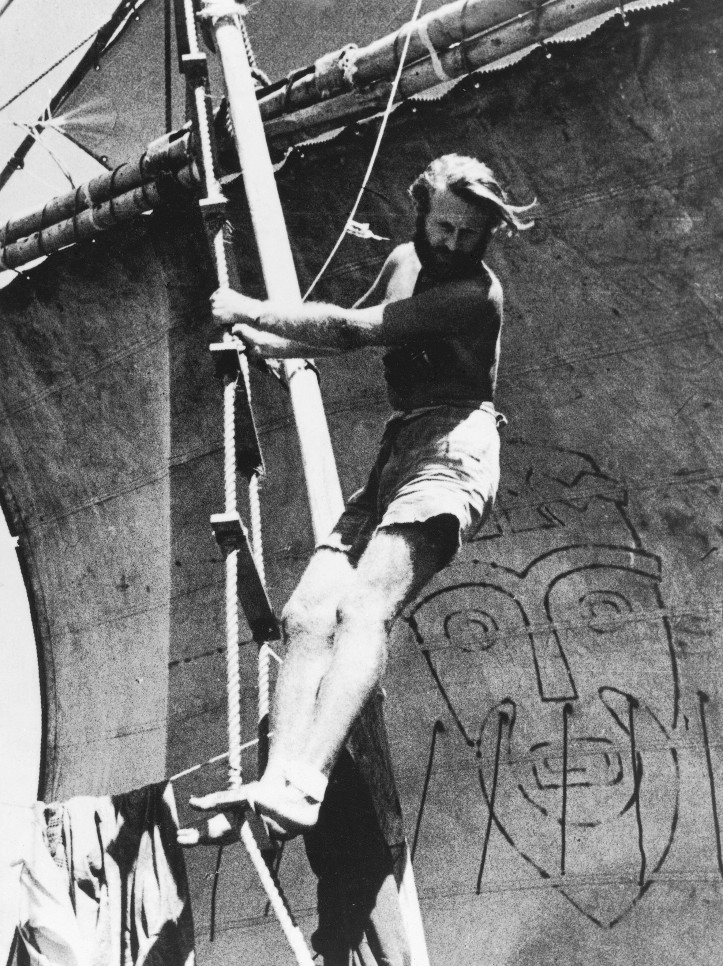
He built the raft itself without using the most recent advances in science – after all, the point was to prove that the Incas could make something that could sail several thousand kilometres across the Pacific. Based on the descriptions of rafts built by the Peruvian natives, Heyerdahl didn’t use screws or nails, instead binding balsa tree trunks together with rope and strengthening the entire structure with bamboo stalks. Balsa is itself a phenomenon – a very soft and light wood, much lighter even than cork. That’s why the Incas used balsa logs to build rafts. The best place to get it was Ecuador, but Heyerdahl found he could only buy boards and sawn logs – useless from his point of view. He was told to wait half a year, until the end of the rainy season, for dried trunks. The Norwegian had neither the time nor the patience, so he went to the jungle. A few weeks later and a few thousand kilometres away, in the middle of the Pacific, it turned out that everything had worked out well. First, the juices in the freshly cut tree were water-resistant. If he had used dry logs, they would have gradually soaked up the water, and the raft would have slowly bent under the weight of its passengers, finally sinking somewhere in the middle of the ocean. Second, defying the warnings of experienced sailors who said that the hemp ropes holding the raft together wouldn’t last more than 14 days, the opposite happened. The structure held together more and more strongly, as the ropes didn’t wear through, but slowly sank into the soft balsa wood.
The raft was made up of nine balsa tree trunks. In the middle was a bamboo hut covered with banana leaves. Next to the entrance stood two masts, and on the sail was an image of the expedition’s patron, Kon-Tiki.
In the port in Callao they didn’t think the expedition stood a chance – there would be hurricanes, storms and waves, and that empty husk would fall apart before it got over the horizon. Just before they left, Heyerdahl’s team was given a Bible by people who explained that during their trip it would come in very handy.
How to steer a balsa raft
The Kon-Tiki’s crew was made up of five Norwegians, one Swede, the parrot Lorita (who was swept away by a wave and didn’t make it to the end) and the crab Johannes. On land, the expedition was supported by Gerd Vold Hurum, a secretary at the Norwegian embassy in Washington, who communicated with the raft by radio (also supplied by the Army) and delivered the news to the world. She was also the raft’s godmother: in Callao she christened it with a coconut, partly to maintain historical consistency, and partly because the bottle of Champagne had mistakenly been packed away too deep.
A tugboat towed the raft out of the port, and then Kon-Tiki was on its own. It quickly turned out that the voyagers, including a World War II veteran, a sociologist and an engineer (sailing skills weren’t Heyerdahl’s top priority) couldn’t steer the thing they’d built. The Incas hadn’t left any instructions. The travellers learned to steer the raft only once they were out on the high seas. On the one hand, Kon-Tiki moved very slowly (an average of 42.5 nautical miles, or 78.5 kilometres, per day). On the other hand, the winds were pushing her in the right direction, and after all, this trip was more about direction than speed.
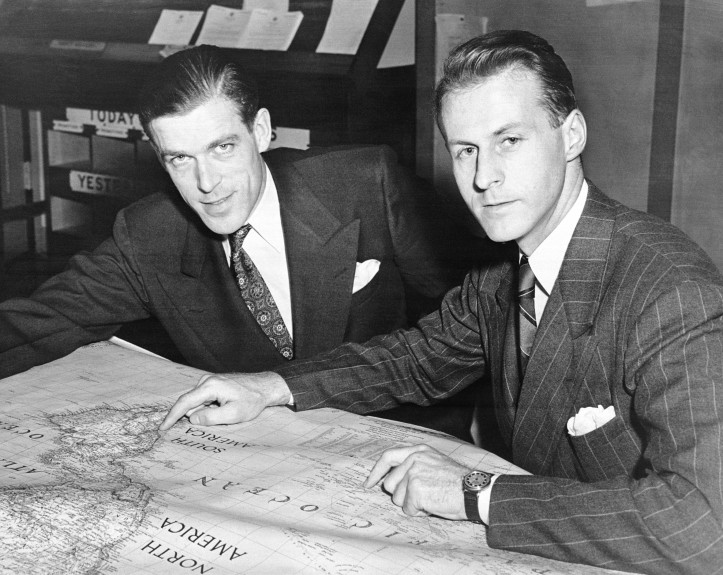
The crew members ate American rations, and seafood that literally jumped on board. Flying fish landed on the raft almost every day. In addition, the Scandinavians caught tuna, mackerel and sharks. After a few weeks it turned out that the drinking water had gone bad. But by then Kon-Tiki was already in the zone of heavy tropical rains, which restored their supplies in no time. The crew faced problems with the weather; during storms, they faced waves as high as six metres, but the expedition was never threatened. On 7th August 1947, the raft made it to Raroia reef, not far from the Tuamotu archipelago. The voyage had lasted 101 days.
The Kon-Tiki expedition didn’t prove that Indigenous Americans had settled Polynesia. It only showed that they could have sailed from one place to the other. Heyerdahl’s great undertaking was more a traveller’s adventure than a scientist’s research, though the Norwegian’s ambitions were primarily scientific.
“Borders? I have never seen one”
The book Kon-Tiki didn’t make it past the Iron Curtain until de-Stalinization. Earlier it was supposedly blocked by Stalin himself, who didn’t like it that the American version included a photo of the crew holding an American flag during a meeting with President Harry Truman, with the White House in the background. As evidence of the emotions that Heyerdahl’s feat evoked in the countries of True Socialism, it’s enough to mention that in 1959 Mlody Technik magazine published instructions for building “an inland raft”. Referring to the Norwegian expedition, of course.
In the fourth Polish edition of Kon-Tiki, from 1963, translator Jerzy Pański wrote about the 2.5 million copies sold around the world. Today, it’s estimated that Heyerdahl sold a total of more than 50 million copies of his opus magnum. The film made during the voyage won the Oscar for Best Documentary in 1951.
A few years later, the book American Indians in the Pacific: The Theory behind the Kon-Tiki Expedition was published. The 821-page manuscript weighed two-and-a-half kilograms. The uncharitable say that describing a book primarily by its dimensions also says a lot about its content. In it, Heyerdahl wrote that the people of Polynesia were descended from two waves of migration. The first was made up of the “white bearded men”. They were tall, blue-eyed, with light or red hair. They were peace-loving, and were great navigators. First, they created a highly developed civilization in Central and South America, but around 500 CE they were driven out, crossing the Pacific with Viracocha to reach Polynesia. The second wave of migration started around 1000 CE, according to Heyerdahl, and was made by people he called the Maori-Polynesians. They were part of the “yellow-brown” race, originated in Asia and were great warriors. Heyerdahl claimed that they had made it to the Americas through the Bering land bridge that once connected Siberia with Alaska [although it is not clear how, given that the land bridge was likely covered by the sea around 11,000 years ago – ed. note]. From British Columbia, on the west coast of today’s Canada, they sailed south. First, they landed in Hawaii, and later on other islands. The “Maori-Polynesian” warriors slaughtered (or possibly assimilated) the “white bearded men”.
It was difficult to even respond to any of this. Still today, there is no evidence that the “white bearded men”, who wandered the world founding one civilization after another, ever existed. Already then, in the 1950s, when Rosa Parks couldn’t choose her seat on an American bus, some reviewers of the book pointed out that Heyerdahl’s theses were racist. The clear majority also pointed out his methodological failings – the Norwegian valued his own experience higher than the results of research and data from scientific works. From the latter he took only what confirmed his theses. “The author’s unquenchable enthusiasm for his theories is evident on every page,” the American archaeologist Ralph Linton wrote in a review of American Indians in the Pacific. “Again and again the ‘possibility’ cited in one paragraph becomes a ‘probability’ in the next and an established fact half a page later. Another book half the size of this would be required to deal with his evidence adequately.” Heyerdahl responded to these and other criticisms with his refrain about David and Goliath, or with one of his bon mots: “Borders? I have never seen one. But I have heard they exist in the minds of some people.” And he organized more expeditions.
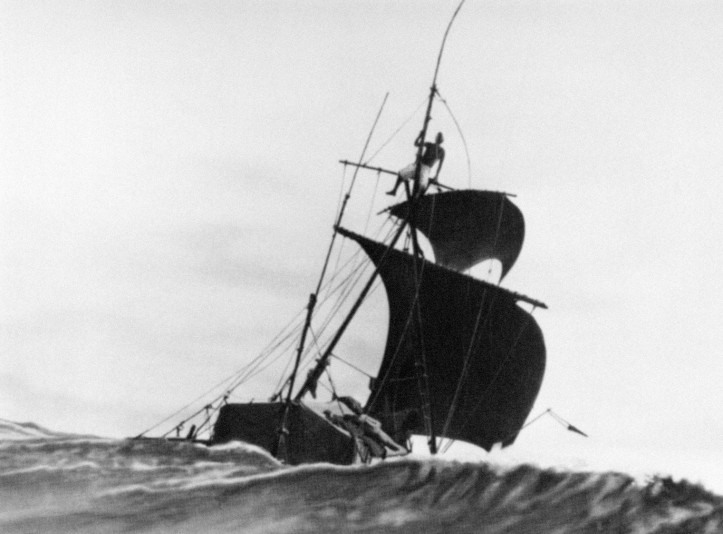
On the Galápagos Islands, he sought evidence that they had been visited by the people of South America in the pre-Columbian era; on Easter Island, he again attempted to prove his thesis that it had been populated by the ancestors of today’s Peruvians. To prove that the ancient Egyptians could have reached America, he organized the Ra expedition. He crossed the Atlantic – though only on his second attempt – in a papyrus boat. He didn’t win a hearing in the scientific community, but he did increasingly use his fame to highlight environmental problems.
Today we know that he saw more than others did – Heyerdahl was sounding the alarm before the environmental crisis was so obvious. He recalled that during the Kon-Tiki expedition, not only did he not meet a single ship, but he also didn’t notice any pollution in the ocean. Two decades later, during the Ra expedition, he saw “far more oil lumps than fish”, plastic bags and bottles, and other rubbish. After this voyage he alerted the UN Secretary-General, which led to a ban on dumping waste in the ocean. In the late 1990s, Heyerdahl wrote that we take the climate for granted, and it seems obvious to us that the last Ice Age has established a permanent climate model on Earth. So, confident in the stability of the environment, we build ports and huge cities along today’s coastlines, but we don’t feel responsible for maintaining this stability. Meanwhile, environmental balance is a question of the entire ecosystem. And he wrote all of this at a time when ‘global warming’ and ‘climate change’ were still on the margins, not at the centre of public debate.
What comes after Thor?
“That was my preparation for the journey – that and […] much colorful and misleading information by the enthusiastic Thor Heyerdahl, who is regarded by many Pacific historians and archaeologists as of minimal consequence to serious archaeology. Scientifically, his books have as little value as those of Erich von Daniken, who theorized that the Easter Island moai were carved by people from outer space,” Paul Theroux wrote in his 1992 book The Happy Isles of Oceania: Paddling the Pacific.
The publication of the DNA research last year didn’t change much. The strongest evidence still supports the idea that the ancestors of today’s Polynesians came from Southeast Asia. Of course, there were meetings between Indigenous people from both sides of the Pacific, but we don’t know where. Scientists don’t rule out that it was the Polynesians, outstanding sailors, who travelled to South America, later returning with cargoes including sweet potatoes.
“Although many of Thor’s ideas were wrong, dismissing them all was overkill. Native American contact was very reasonable and, as we have shown, it happened,” said Alexander Ioannidis of Stanford University, who led the DNA research. A lot of questions remain, while only one element of the Kon-Tiki theory has been scientifically proven.
The rest of Heyerdahl’s ideas aged much worse. Already in the 1990s, the Norwegian had to respond to charges of racism, which take up increasing amounts of space in contemporary works on his theories. Scientists point out that his theory of the “white bearded men” de facto strips today’s Polynesians of their history. The Kon-Tiki Museet, one of Norway’s most popular museums, published an article in April 2020 explaining its patron’s ideas and arguing that the traveller formulated his theses in completely different times, so he can’t be judged by today’s standards.
But it’s indisputable that even in error, Heyerdahl drew the broader public’s attention to subjects that earlier only a narrow group of academics worked on. “Fuelled by Heyerdahl’s fame, the question of Pacific migration patterns became known worldwide and attracted scholars across the globe to ‘prove Heyerdahl wrong’[…]. As a result, the question of Pacific migration routes moved from being a discussion about the existence of sunken fantasy continents to become, some 60 years later, one of the best-documented prehistoric migration processes in human history,” writes Victor Melander of Australian National University.
“The indisputable fruit of the expedition remains a good book, the story of a voyage as interesting and adventurous as the adventures of Jules Verne’s heroes,” translator Jerzy Pański writes in his introduction to the Polish edition of Kon-Tiki. Half a century later and 10 years after Heyerdahl’s death, the fictionalized film Kon-Tiki premiered, winning an Oscar nomination in 2013 for Best Foreign Language Film. So the story itself, of a voyage by raft across the ocean to prove theories about a large-scale pre-Columbian migration, has stood the test of time. But Heyerdahl’s ambitions were greater – and they remain unfulfilled.

Sources: Heyerdahl’s “Fatu Hiva” and “Kon-Tiki”; Paul Theroux’s “The Happy Isles of Oceania: Paddling the Pacific” and Victor Melander’s “The Coming of the White Bearded Men: The Origin and Development of Thor Heyerdahl’s Kon-Tiki Theory”.
Translated from the Polish by Nathaniel Espino


